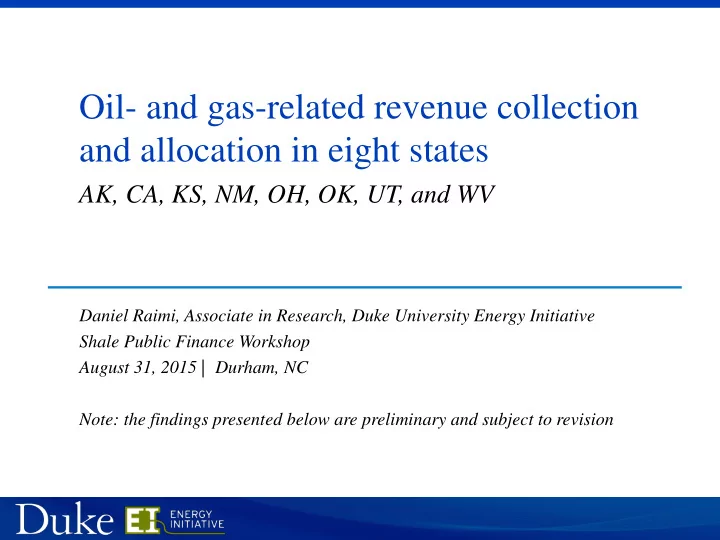

Oil- and gas-related revenue collection and allocation in eight states AK, CA, KS, NM, OH, OK, UT, and WV Daniel Raimi, Associate in Research, Duke University Energy Initiative Shale Public Finance Workshop August 31, 2015 | Durham, NC Note: the findings presented below are preliminary and subject to revision
Focus of this presentation • What government revenues are generated from oil and gas production in our focus states? • How are those revenues allocated across different levels of government? • We look at these issues state-wide for each state • We do not seek to make value judgments about the appropriate level of government revenue Daniel Raimi, Shale Public Finance Workshop 2 Durham, NC March 31 2014
Overview of presentation • Oil and gas revenue mechanisms in eight states • Comparison of oil- and gas-related revenues and allocation • Analysis and discussion questions Daniel Raimi, Shale Public Finance Workshop 3 Durham, NC March 31 2014
We quantify direct government revenues from oil and gas production • State severance taxes or similar • Local ad valorem property taxes on oil and gas property • Lease revenue from state and federal lands • Our calculations do not include – Indirect or induced impacts (e.g., income taxes, sales taxes) – Lease revenue on local government land – These revenues can be substantial Daniel Raimi, Shale Public Finance Workshop 4 Durham, NC March 31 2014
We then quantify allocations to local governments from these revenue sources • How does revenue flow from severance taxes, property taxes, federal leases and state leases? – We focus on flows to local governments rather than state government • We do not quantify revenue flows from state general funds – State-collected severance taxes and lease revenues often go into state general funds, where they may eventually flow to local governments – These flows are generally not related to levels of oil and gas activity Daniel Raimi, Shale Public Finance Workshop 5 Durham, NC March 31 2014
Market value of oil and gas produced in FY 2013 billion $22.5 $20.0 $17.5 $15.0 $12.5 $10.0 $7.5 $5.0 $2.5 $0.0 OH WV UT KS NM OK AK CA Sources: U.S. EIA for oil and gas production volumes and oil prices based on statewide first purchase price. Bloomberg for natural gas prices based on regional market hub prices. Daniel Raimi, Shale Public Finance Workshop 6 Durham, NC August 31, 2015
State and local revenue by mechanism in FY 2013 40% share of production value 35% 16% State lands 30% 14% Federal lands Local property taxes 25% 12% Severance or similar 10% 20% 8% 15% 6% 10% 4% 5% 2% Limited data z 0% 0% OH CA KS UT WV OK NM AK Note: percentage figures do not represent effective tax rates. Daniel Raimi, Shale Public Finance Workshop 7 Durham, NC August 31, 2015
State and local revenue allocation in FY 2013 40% share of production value 35% 16% Local grant program 30% Other local gov't 14% Munis 25% Counties 12% Schools trust fund 10% Local schools 20% Higher ed 8% State legacy fund 15% State general fund 6% 10% 4% 5% 2% Limited data z 0% 0% OH CA KS UT WV OK NM * AK Note: percentage figures do not represent effective tax rates. *Alaska light blue bar represents revenues flowing to Borough governments, which also operate school districts. Daniel Raimi, Shale Public Finance Workshop 8 Durham, NC August 31, 2015
Local government revenue collection and allocation in FY 2013 40% share of production value 35% 16% Schools trust fund 30% Local schools 14% Local grant program 25% Other local gov't 12% Munis 10% Counties 20% 8% 15% 6% 10% 4% 5% 2% No data z 0% 0% AK * OH CA KS UT WV OK NM Note: percentage figures do not represent effective tax rates. *Alaska light blue bar represents revenues flowing to Borough governments, which also operate school districts. Daniel Raimi, Shale Public Finance Workshop 9 Durham, NC August 31, 2015
Analysis of revenue collection and allocation • In most cases, local governments are receiving adequate revenue to manage impacts • Property and sales taxes are leading local revenue sources, and appear to be sufficient in most situations – Volatility can be a challenge • In some cases, additional revenues may be necessary to manage impacts – But it can be difficult to anticipate where fiscal challenges will arise Daniel Raimi, Shale Public Finance Workshop 10 Durham, NC August 31, 2015
Discussion • Do you have any feedback on our calculations and presentation of revenue data? • Do you have any feedback on our analysis of the data? Daniel Raimi, Shale Public Finance Workshop 11 Durham, NC August 31, 2015
For more information Daniel Raimi Associate in Research Duke University Energy Initiative energy.duke.edu energy.duke.edu/shalepublicfinance/ daniel.raimi@duke.edu 919-886-1952 Note: the findings presented above are preliminary and subject to revision Daniel Raimi, Shale Public Finance Workshop 12 Durham, NC August 31, 2015
Recommend
More recommend